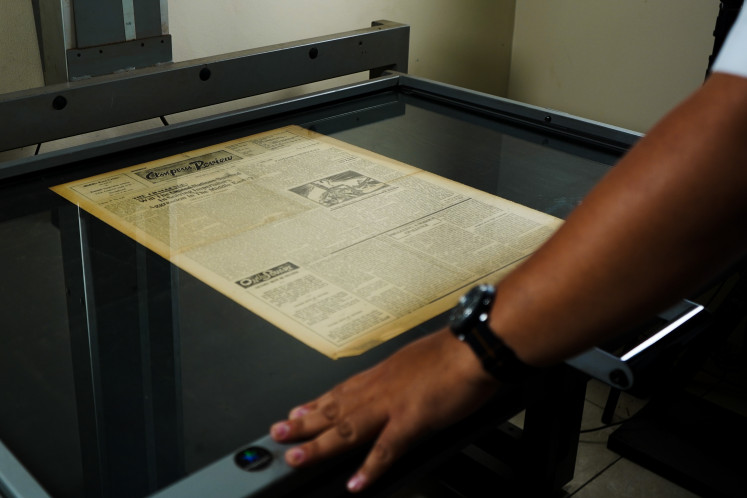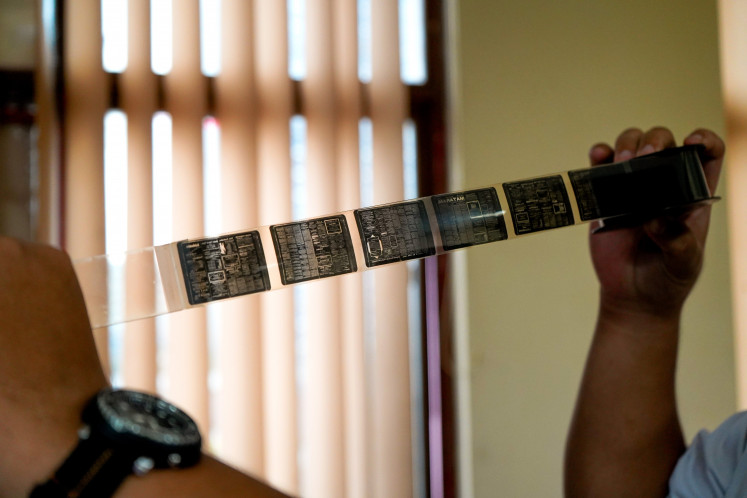Popular Reads
Top Results
Can't find what you're looking for?
View all search resultsPopular Reads
Top Results
Can't find what you're looking for?
View all search resultsDigitizing Indonesia’s newspapers before they fall to pieces
Change text size
Gift Premium Articles
to Anyone
As Indonesia’s historic newspapers perish in the archives, the country risks forever losing the voices of its past.
“We can see the physical condition, it already has some fungi,” said Faisal Huzein, a staff member at the National Library of Indonesia’s (Perpusnas) Preservation Center. He held up an unfurled roll of microfilm to the window, exposing the chain of newspaper pages. Their miniature headlines and columns of text were clouded from decay. “It’s in a bad condition, a really bad condition.”
While microfilm has long been a popular method of preservation, it does not last forever.
Across the world, archives and libraries are racing to digitize their collections. By scanning and uploading newspapers to online platforms, these papers can be protected in perpetuity, made accessible and searchable to the masses. But in Indonesia, most historic newspapers remain endangered. As they disintegrate, a trove of voices from the archipelago’s past is at risk of being permanently lost.
Losing the paper trail
Perpusnas houses one of the largest collections of Indonesian newspapers in the world. Only single copies remain for most of the issues in the collection. The vast majority of these are yet to be scanned and uploaded to the library’s online platform, Khastara, which was launched in 2019.
To date, approximately 2.5 percent of the collection has been digitized.
Even for the newspapers that are on Khastara, the system does not allow users to search by text. “If you’re trying to extract information from the newspaper […] if you are looking for [a specific] article, it’s impossible,” said Faisal.
“The facilities are inadequate and newspapers have second priority to be digitized compared with manuscripts,” added Wirantna Tritawirasta, coordinator of Perpusnas’ preservation team.
In total, 1.6 million newspaper issues are held by Perpusnas. They consist of more than 16 million separate rare newspaper pages. Of the issues that are microfilmed, only 11,000 are identified as being in good condition.
“The Indonesian voice in history is being throttled by natural decay, neglect, and sometimes corruption,” said Gerry van Klinken, an honorary research fellow at the Royal Netherlands Institute of Southeast Asian and Caribbean Studies (KITLV).
Scanning the headlines: Faisal Huzein digitizes a newspaper at the Preservation Center (JP/Kate Newsome) (JP/Kate Newsome)Van Klinken told The Jakarta Post that while accounts of Indonesia’s last century have been passed on through oral histories, as this generation passes away, preserving Indonesian newspapers is essential “if we want a history that’s real, that’s human, that has flesh and blood in it”.
“[Indonesia’s provinces] are an absolute wasteland to research,” said Van Klinken, recalling the challenges he faced while studying Kupang, a town in which none of its nine Indonesian-language newspapers from the 1930s have survived completely. This experience would inspire him to write the 2019 journal article “Endangered; When newspaper archives crumble, history dies”.
While Indonesian perspectives of history have begun to dissipate, the Dutch archives, Van Klinken said, are pristine. Peripheral and provincial perspectives, preserved in fading newsprint, must contend with the colonial authorities’ daily military reports and stringent newspaper collection policies.
Van Klinken recalled an interaction with historians collaborating on a book about the Indonesian National Revolution. “The younger ones were saying they were trained with the idea that the only place that is an authentic repository of history are the Dutch archives because they are complete,” he said.
Preservation’s imperfections
“Physically, newspapers are very fragile but the content about Indonesia is very valuable,” said Atikah, a librarian working in the Perpusnas rare newspaper services. Cut pages and torn edges flake onto the table as she opens a binder to reveal a yellowed stack of papers.
“The problem with [these] newspapers is the quality of printing [...] they had the idea, the spirit to publish about nationalism, Indonesia, human rights but maybe they didn’t have enough money,” she said.
Poor quality paper and printing was ubiquitous among smaller provincial publishers. Just as historically rushed and under-funded microfilming projects have led to more volatile film rolls, these cheaply made newspapers are more likely to become brittle due to paper acidity.
After years of decay as well as several chaotic moves and mix-ups, there is no illusion that the library has an accurate inventory of its collection, Van Klinken concludes. “People have torn pages out because they want a keepsake, or perhaps they’re offended by the content. They’re leaking away as we speak.”
Opening up the archives
“This is about democratizing history,” Van Klinken said, emphasizing that for these newspapers to be of any use they must be accessible and searchable for all.
From Australia to the United Kingdom, several international archiving programs and national libraries contacted by the Post voiced a strong interest in digitizing Indonesia’s historical newspapers. However, they all faced the barrier of ownership. Even at Perpusnas, a newspaper issue needs to have been published 50 years ago or longer for it to become freely available on Khastara.
Reel problems: A strip of microfilm that has begun to deteriorate (JP/Kate Newsome) (JP/Kate Newsome)Gregory Green, Southeast Asia collections curator at Cornell University’s Kroch Library, has been involved in several attempts to digitize Indonesian newspapers to little avail. “I have a box full of hard drives that contain years’ worth of digital files of newspapers from all over Indonesia that a major bank research project created, but didn’t have copyright permission from publishers.”
While this was not a problem for the researchers, he said, “for us, the files are useless unless we get permission to host them online.”
Permanently in print
It is slow work digitizing Perpusnas’ newspaper collection. The preservation team faces a daunting physical and logistical challenge in scanning large and incredibly delicate broadsheets before they are eradicated.
But, Van Klinken concluded, “Once it’s [digitized], it’s forever.”
“History repeats itself,” he said. “People have forgotten that [Indonesia’s struggles] have strong and deep roots. It’s a historical experience that’s worth remembering and worth democratizing.”













